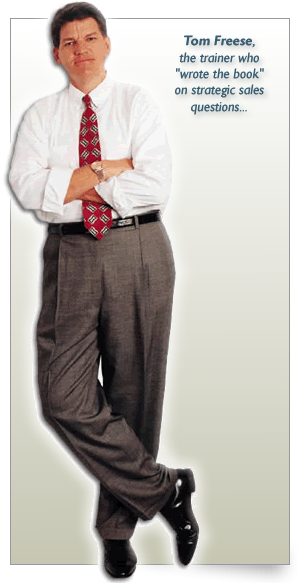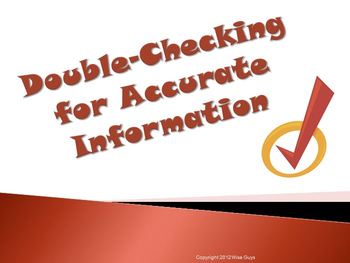
 Intro– Companies all over the world spend millions telling people what to say, but spend almost nothing teaching them what to ask? In sales, questions are important. What a salesperson asks…and how they ask, is more important than what they will ever say.
Intro– Companies all over the world spend millions telling people what to say, but spend almost nothing teaching them what to ask? In sales, questions are important. What a salesperson asks…and how they ask, is more important than what they will ever say.
Chapter 8- Sellers begin to have credibility when prospects form a favorable impression about their competence and value. When you are perceived as credible, opportunities to provide valuable solutions will be abundant. Sellers start with near-zero credibility. Leverage existing relationships. Managing the scope of your questions- Scope is the first of three attributes used to characterize strategic questions; the other two are focus and disposition. Open –ended questions are great tools for expanding relationships, but they don’t help establish your credibility. Prospects will base their impressions on the statements you make. Prospects will form impressions quickly-based on the statements you make, and the questions you ask. Prospects are reluctant to answer questions until the salesperson has proven that he or she is indeed credible. When you demonstrate an ability to ask intelligent and relevant questions, prospects will automatically perceive a higher level of competence, credibility, and values. If a prospect who is curious also believes that you are credible, then uncovering needs and presenting solutions is easy. Use diagnostic questions to open your presentation. Diagnostic questions are also useful for breaking the ice in your sales presentations. For most prospects, it’s easier to make decisions on smaller components of a sale than to tackle the larger purchase in its entirety. To be perceived as an expert, ask expert questions. Early in the sales process, your objective is building credibility, to communicate an increased sense of competence and expertise. By establishing credibility, salespeople earn the right to broaden the scope of their sales conversations. Closed-ended questions are great credibility building tools, but you can’t build a house if your only tool is a hammer.
Chapter 9- A fine line exists between asking productive questions and “pumping” your prospects and customers for information. In order to dissect a sales conversation-Status questions, Issue questions, Implication questions, or Solution questions. Most purchase decisions are emotional, and prospects have to feel that they are making the right decision. Status questions and Issue questions are analytical in nature. A status question probes for specific pieces of information that will help reveal the current “status” of a prospect opportunity. Status questions are low in mutual value because prospects aren’t learning anything new. They already know the status. Greater needs cause prospects to feel a greater sense of urgency for finding a solution and making a purchase. People aren’t going to buy just because a problem or a desire surfaces as an issue. Issues become detrimental enough. The more implications you uncover, the easier it is for prospects to justify a favorable purchase decision. Issue and Implication questions work together. Every time you uncover an issue, you should probe further by asking Implication question to understand the prospect’s thoughts, feelings, and concerns about that particular issue. Global Questions-“How do you mean?” is very different than asking “What do you mean?” It causes people to get defensive. Solution questions are valuable closing tools. Discussion of issues, problems and the benefits. Solution questions motivate prospects to move forward by focusing their attention on solving the problem. Prospects don’t want to be “told” and they certainly don’t want to be pushed. That’s why it’s smart to make closing their idea. Prospects are motivated to respond when they recognize that by helping a salesperson, they’re actually helping themselves.
 Chapter 10- Accurate information is one of your most valuable assets in the sale. Most prospects are reluctant to share bad news, and most salespeople aren’t particularly good at asking for it. Most salespeople don’t want to hear bad news. The risk of failure and the possibility of hearing bad news makes the “hard” questions in sales very difficult to ask. Most people would rather sidestep a difficult issue, or make up a convenient excuse, than be the bearer of bad news. Soliciting feedback from your prospects and customers isn’t difficult. What’s difficult is soliciting open, honest, and accurate feedback. If you want open, honest, and accurate responses, then you need to make it OK for prospects to openly share. Neutralizing the disposition of your questions is easy. Simply offer the prospect a choice to respond either positively or constructively. A question is neutralized when you introduce the negative. Having an accurate read on your sales opportunities gives you a strategic advantage over your competition. Competent professionals aren’t afraid of hearing bad news, and they don’t ask questions positively, hoping to generate a more favorable response. Inserting the negative into your sales questions cause positive responses from prospects to become emphatically more positive. When you insert “the negative” into your questions, people will jump to your emotional rescue. Humbling disclaimers give other people in the conversations a chance to rescue you before you even deliver the questions.
Chapter 10- Accurate information is one of your most valuable assets in the sale. Most prospects are reluctant to share bad news, and most salespeople aren’t particularly good at asking for it. Most salespeople don’t want to hear bad news. The risk of failure and the possibility of hearing bad news makes the “hard” questions in sales very difficult to ask. Most people would rather sidestep a difficult issue, or make up a convenient excuse, than be the bearer of bad news. Soliciting feedback from your prospects and customers isn’t difficult. What’s difficult is soliciting open, honest, and accurate feedback. If you want open, honest, and accurate responses, then you need to make it OK for prospects to openly share. Neutralizing the disposition of your questions is easy. Simply offer the prospect a choice to respond either positively or constructively. A question is neutralized when you introduce the negative. Having an accurate read on your sales opportunities gives you a strategic advantage over your competition. Competent professionals aren’t afraid of hearing bad news, and they don’t ask questions positively, hoping to generate a more favorable response. Inserting the negative into your sales questions cause positive responses from prospects to become emphatically more positive. When you insert “the negative” into your questions, people will jump to your emotional rescue. Humbling disclaimers give other people in the conversations a chance to rescue you before you even deliver the questions.
 Chapter 11- “Selling” is not an activity…..it’s a process. The most successful salespeople are the ones who follow a consistent and repeatable sales process. Most of your invested sales effort is spent generating interest and moving prospects forward toward closure. Whether a prospect enters the sales process on their own or you initiate contact via a sales call, it’s up to you to pique their interest and keep them engaged. Sellers must accumulate enough value to get their prospects to want to move into the next phase of the sales process. Salespeople who are the most effective typically have the largest pipelines and the greatest sales results. If you believe the old saying, the customer is always right, and then you forfeit your opportunity to add value. Expecting customers to control the sales process opens a salesperson up to significant risk. Buyers need direction from sellers, or at the very least, clues that will show them how best to proceed. In reality, prospects don’t always know how to proceed in addressing them. Top performers control the sale (using questions) while average performers let themselves be controlled by the sales process. Asking questions enables you to manage your sales conversations. Questions are valuable tools for managing the sales process because they soften your suggestions. This enables salespeople to be more assertive without making prospects feel pressured or pushed. Questions allow sellers to offer ideas and raise aspects of a decision that prospects might not otherwise consider. Make no mistake; asking questions puts you in a position of strength. Answer a question with a question. When people asks questions, it’s important to know why they’re asking in order to know how best to respond. Unfortunately, silence makes some salespeople very uncomfortable. As a result, they jump into the conversation to fill the silence with noise. You must resist this temptation, however, because if you don’t fill the silence with noise, your prospects will fill it with valuable information.
Chapter 11- “Selling” is not an activity…..it’s a process. The most successful salespeople are the ones who follow a consistent and repeatable sales process. Most of your invested sales effort is spent generating interest and moving prospects forward toward closure. Whether a prospect enters the sales process on their own or you initiate contact via a sales call, it’s up to you to pique their interest and keep them engaged. Sellers must accumulate enough value to get their prospects to want to move into the next phase of the sales process. Salespeople who are the most effective typically have the largest pipelines and the greatest sales results. If you believe the old saying, the customer is always right, and then you forfeit your opportunity to add value. Expecting customers to control the sales process opens a salesperson up to significant risk. Buyers need direction from sellers, or at the very least, clues that will show them how best to proceed. In reality, prospects don’t always know how to proceed in addressing them. Top performers control the sale (using questions) while average performers let themselves be controlled by the sales process. Asking questions enables you to manage your sales conversations. Questions are valuable tools for managing the sales process because they soften your suggestions. This enables salespeople to be more assertive without making prospects feel pressured or pushed. Questions allow sellers to offer ideas and raise aspects of a decision that prospects might not otherwise consider. Make no mistake; asking questions puts you in a position of strength. Answer a question with a question. When people asks questions, it’s important to know why they’re asking in order to know how best to respond. Unfortunately, silence makes some salespeople very uncomfortable. As a result, they jump into the conversation to fill the silence with noise. You must resist this temptation, however, because if you don’t fill the silence with noise, your prospects will fill it with valuable information.
Chapter 12- Initiating contact is a difficult challenge. Average success rate is typically 2 to 5 percent so out of every hundred sales calls; you can expect to generate only a small handful of opportunities. Most prospects view a cold call as an unwelcomed interruption rather than a valuable use of their time. Very few sales are consummated during the initial sales call, but this is where many sales opportunities are lost. Use humbling disclaimers to minimize risk “Did I catch you at a bad time?” A salesperson should have a valid reason for calling, one that piques the prospect’s interest so they will want to engage further. Associative references won’t close the sale, but they can give you an opening to execute a strategy that will. Whenever someone agrees that they are the right person, you automatically earn the right to probe further. Narrowing the scope of your questions establishes your credibility so you can broaden the scope of your questions to uncover needs and build relationships. Prospects don’t respond well to rhetorical questions. A vague-o-mym is a word (or phrase) that is so vague that it’s impossible to know what the other person means without additional information. The meaning of everyday words depends on the context in which they are used and the biases of the people involved. The idea of clarifying vague-o-nyms makes some salespeople nervous because they wouldn’t want their prospects to think they aren’t listening. How can you make sure your prospects are ready to listen? The answer is, by making them curious enough to want more information about how your product can address their specific needs. Salespeople can rant and rave about their products without sounding arrogant. They sound arrogant when they start ranting and raving about themselves. The prospect’s acceptance of your offer to engage further marks the beginning of your sales effort, not the end.
Chapter 13- While some prospects micromanage every decision, others are more likely to solicit input from, or delegate responsibility to, someone else. This idea that you’ll find greater decision-making authority at the top of the organization has made it fashionable to train salespeople on using a top-down approach-contacting the top officer in a company first. Some of the most exciting sales opportunities begin with someone other than the very important top officer. High-level contacts have the authority to make a decision, or the ability to bring together people who can. Lower-level personnel tend to be more accessible. Calling low in an organization also gives you an opportunity to develop internal champions. The greatest risk of calling low is being blocked by someone who doesn’t have the authority to make a decision. The decision maker is the person in the account who will ultimately “pull the trigger” on the decision to purchase. Not everyone can pull the trigger and make a decision, but lots of people can pull the plug on your opportunity to sell. Influencers are people that decision makers listen to, and can definitely affect your outcome. Key influencers are able to influence opinions and create a very powerful voice in the final decision. Anyone in an account who doesn’t understand the value of your product or service will ultimately vote against it. One of the challenges salespeople face when talking to more than one person within the account is conflicting information. When multiple people give the same response, the information you are getting is probably accurate.
Chapter 14- The value you build in the sales presentation is what ultimately justifies a favorable purchase decision. The forma of a sales presentation can vary dramatically depending on the product you sell and the audience you’re selling to. At the beginning of the sales process, salespeople have near-zero credibility. The beginning of a presentation sets the tone for the rest of the event. If you are presenting to a committee, it’s always better to be introduced by someone from the audience, than to walk up and introduce yourself. Deliver an interactive opener. Shy away from canned openings. When prospects identify with you personally, they’re most likely to identify with your presentation and your solutions. Ask, “What would you like for me to accomplish in the presentation?” An interactive opener lets prospects know that you plan to tailor your presentation to make good use of their time. The presentation is the salesperson’s opportunity to educate prospects on the value of their solutions. The greater the prospect’s need, the more value you will be able to deliver in the presentation. Just because you know where you want to go in the presentation, doesn’t mean the rest of your audience will want to go there. Telling prospects why an issue is important often causes them to mismatch, telling you why it’s not. The problem is, whenever salespeople try to tell audiences what their issues are, audiences tend to resist. If you take time to say it…..take time to explain it. This is critical in the sales presentation. How your sales presentation ends is important because the last impression typically leaves a lasting impression. If the prospect likes your presentation enough to request a proposal, you earn the right to suggest all kinds of follow-up events.
 Chapter 15- Most prospects are nervous in the final stages of a sale. It’s a natural reaction-people get nervous whenever they have to make a commitment. Closing isn’t something you do to somebody; rather, it’s a mutual experience you have with them. Giving away too much isn’t mutually beneficial. Sellers have at know when to add value….and when to stop. Prerequisites to closing sales-Recognize a need, a viable solution, value must justify the cost, a sense of urgency and have the authority to buy. Soliciting feedback is important, but even more important to solicit complete and accurate feedback. The real challenge in closing sales is having a complete and accurate status. It’s amazing how many people will suddenly open up when their comments are considered “off the record.” The alternate choice close-give two viable alternatives or choices. Salespeople who expend effort and provide value should expect to get something in return. For prospects that have pressing needs, not buying your product or service might be their most expensive option. Most purchases are highly emotional. Spending a few minutes to make customers feel special is more significant than spending hours to make them feel average. A champion who understands how to sell your product or service is worth their weight in commission checks.
Chapter 15- Most prospects are nervous in the final stages of a sale. It’s a natural reaction-people get nervous whenever they have to make a commitment. Closing isn’t something you do to somebody; rather, it’s a mutual experience you have with them. Giving away too much isn’t mutually beneficial. Sellers have at know when to add value….and when to stop. Prerequisites to closing sales-Recognize a need, a viable solution, value must justify the cost, a sense of urgency and have the authority to buy. Soliciting feedback is important, but even more important to solicit complete and accurate feedback. The real challenge in closing sales is having a complete and accurate status. It’s amazing how many people will suddenly open up when their comments are considered “off the record.” The alternate choice close-give two viable alternatives or choices. Salespeople who expend effort and provide value should expect to get something in return. For prospects that have pressing needs, not buying your product or service might be their most expensive option. Most purchases are highly emotional. Spending a few minutes to make customers feel special is more significant than spending hours to make them feel average. A champion who understands how to sell your product or service is worth their weight in commission checks.
